Physical Address
304 North Cardinal St.
Dorchester Center, MA 02124
Dentoalveolar evaluations should be accomplished prior to radiation therapy (RT) in the interest of establishing lifelong prognoses for those teeth to be included in potential radiation fields. Teeth with poor prognoses should be extracted before RT, preferably at the time of a surgical ablation, if such is planned.
The risk of osteoradionecrosis (ORN) secondary to invasive dentoalveolar procedures is substantial in areas that have received more than 5000 cGy of radiation.
The Marx hyperbaric oxygen regimen is used to diminish the risk of ORN when invasive dentoalveolar procedures must be done in areas that received more than 5000 cGy of radiation.
Xerostomia-induced carious lesions are common among patients whose major salivary glands are included in radiation fields. Topical fluoride gel and meticulous oral hygiene are paramount for the prevention of carious lesions for patients who have been rendered xerostomic secondary to RT.
Maxillofacial prosthodontists can offer radiation oncologists a host of devices to lend assistance to the delivery of RT. These include shielding and positioning, tissue equivalency, and brachytherapy devices.
Maxillofacial prosthodontists can offer assistance in evaluating the relative safety associated with invasive dentoalveolar procedures following RT by way of evaluating dose distributions, simulation radiography, and computed tomography.
Maxillofacial prosthodontists are uniquely positioned to mitigate palatopharyngeal insufficiency or palatopharyngeal incompetence through the fabrication of palatal lift, speech aid, and obturator prostheses.
Maxillofacial prosthodontists routinely offer mandibular resection prostheses for patients with discontinuity defects or defects that have been reconstructed with microvascular free flap procedures.
Endosseous titanium implants are often necessary for the rehabilitation of patients with congenital or acquired intraoral and extraoral dentoalveolar and maxillofacial defects. Endosseous titanium implants are often placed in grafted microvascular osseous tissues and in native maxillary or mandibular bone.
Maxillofacial prosthodontists work closely with speech-language pathologists to prosthetically mitigate dysfunctional articulation and dysphagia.
Orbital, ocular, nasal, and auricular prostheses constitute the most common extraoral prostheses provided by maxillofacial prosthodontists.
The construction of facial prostheses requires impression making, wax or clay sculpting, fabrication of molds, casting of pigmented elastomers such as silicone, and painting surface skin tones.
Maxillofacial prosthetics comprises a subspecialty of prosthodontics directed toward the prosthetic habilitation of patients with congenital maxillofacial defects, the prosthetic rehabilitation of patients with acquired maxillofacial defects, and the medical management of patients who undertake treatment for essentially any maxillofacial pathosis. Maxillofacial prosthodontists are often involved in hospital-based multidisciplinary craniofacial and cleft lip and palate teams and head and neck oncology teams, either as institutional staff members or as participating private practitioners. The maxillofacial prosthodontist's role in patient care often begins with an otolaryngology or oral and maxillofacial surgery referral at diagnosis, because the prosthodontist's contribution early in the course of a patient's care can foster the prosthetic management necessitated by either the patient's condition or the treatment of the condition. This is true for patients affected by congenital anomalies or trauma-related anatomic deficits and for oncology patients treated primarily by ablative surgery, radiation therapy (RT) alone, or combinations of surgery, RT, and chemotherapy.
Because the treatment of head and neck cancer has evolved into a complex multidisciplinary approach, the maxillofacial prosthodontist's participation in the tumor boards of centers that actively treat oncology patients can be quite meaningful. Prosthetic care may address common issues that relate to routine dental health and occlusal rehabilitation as well as matters as diverse as dysphonia, dysphagia, and facial cosmesis, so the prosthodontist's diagnostic input before a surgical ablation can assist the reconstructive phase of virtually all head and neck oncology patients regardless of the primary tumor site. Additionally, the maxillofacial prosthodontist's diagnostic contribution for patients who have or will be treated with RT can aid in the prevention of osteoradionecrosis (ORN) and can obtund or prevent mucosal or dental disease in patients who suffer from early or late effects of RT. The maxillofacial prosthodontist's role is also paramount in the evaluation of dose distributions to assist safe oral surgical care, when it is necessary after RT.
This chapter reviews some of the duties of maxillofacial prosthodontists associated with multidisciplinary head and neck oncology teams from the perspective of two staff maxillofacial prosthodontists in different tertiary care settings. Although the chapter principally relates to an oncology population, the sections that pertain to intraoral and extraoral prosthetic rehabilitation correspond quite readily to patients whose defects are traumatically acquired or congenital.
Given that the treatment of head and neck neoplasms often involves RT alone or in combination with surgical ablation or chemotherapy, it is useful for the maxillofacial prosthodontist to become involved in patient care during the diagnostic phase of any proposed intervention. Because the risk for ORN is increased when poor dentition is allowed to remain within irradiated maxillary or mandibular alveolar bone, a thorough evaluation of the dentition and periodontium is extremely useful in establishing dental prognoses before the initiation of RT. Additionally, because the xerostomia induced by a majority of head and neck radiation fields requires an increased diligence in respect to home care and follow-up during and after RT, the maxillofacial prosthodontist's early consultation can help prevent dental disease that could later contribute to added debility, possibly including ORN.
Because many head and neck cancers are treated by surgical ablation followed by RT, the maxillofacial prosthodontist's diagnostic efforts should be performed preoperatively so that any necessary oral surgical interventions can be accomplished in conjunction with the otolaryngologist's surgical encounter. This allows a sufficient amount of time for mucosal and alveolar bone healing before the initiation of RT, which usually occurs 6 weeks later. Patients whose dentoalveolar evaluations are accomplished after ablative surgeries are sometimes fast approaching a juncture in their care when RT should expeditiously commence in the interest of controlling local and regional oncologic disease, and delays associated with healing oral surgical wounds may be unacceptable. Likewise, the maxillofacial prosthodontist must consider similar delays in the initiation of RT when treatment plans call for primary RT or for RT to be delivered concurrently with chemotherapy in the absence of an ablative surgical encounter.
Any dentoalveolar evaluation in preparation for RT should include a thorough assessment of the periodontium, as well as the dentition, and should be done with the intent of establishing lifelong prognoses for those teeth likely to be included in RT fields anticipated to receive doses in excess of 5000 cGy.
Extractions are indicated for teeth with poor prognoses that meet the criteria listed in Box 93.1 . Although the assessment is accomplished in the interest of preventing ORN, it is also done considering the potential for any prosthetic rehabilitation that may become necessary. Because this assessment requires consideration of primary tumor size and location and regional lymph node status, diagnostic information gleaned through participation in multidisciplinary head and neck tumor board conferences supplements decisions made in the dental clinical setting, where medical imaging is limited and endoscopy is not typically available.
5-mm periodontal pockets
Class I, II, or III furcation involvement
Active endodontic or periapical pathosis
Mobile primary teeth
Nonrestorable teeth
Nonfunctional or unopposed teeth
Impactions
In addition to an evaluation of the dentoalveolar structures, the maxillofacial prosthetic assessment includes panoramic radiography, intraoral and extraoral palpation and visualization of hard and soft head and neck tissues, and intraoral radiography of those teeth thought to be sound enough to retain vis-à-vis imminent RT. Although the intraoral radiography generally includes routine bitewing and periapical exposures, occlusal radiographs are sometimes helpful for primary tumor staging by affirming bony erosion associated with oral cavity lesions that affect the gingivae, buccal or palatal mucosa, or floor of the mouth.
With respect to the periodontium, teeth with periodontal sulci equal to or greater than 5 mm in depth may be assigned poor prognoses and should be considered candidates for extraction before RT. Likewise, teeth with mucogingival defects or furcation involvement should be given similar prognoses and should be considered for extraction. Although prior successful endodontic treatment should not necessarily condemn a tooth for extraction, the unpredictability of endodontically treating active periapical or pulpal pathoses in the usually limited time available before RT should give rise to enough caution that the extraction of endodontically involved teeth should be strongly considered. Although gingival recession is not in itself a definite indication for exodontia in the absence of deep periodontal sulci, consideration must be given to the maintenance of radicular surfaces exposed to the xerostomic oral environment as a result of recession, because cementum is more prone to the development of inoperable carious lesions than is the more mineralized coronal enamel.
With regard to the dentition, mobile primary teeth should be extracted from alveolar bone to be irradiated, as should any unrestorable teeth. If no plan can be made to restore the occlusion of unopposed posterior teeth that will be irradiated, consideration should be given to their extraction, because subsequent supraeruption can contribute to expansive gingival embrasures that are difficult to maintain free of plaque and food debris; these can result in localized periodontitis or radicular carious lesions that are difficult or even impossible to repair. Although the extraction of impacted teeth from alveolar bone soon to be irradiated is meritorious, consideration should be given to the length of healing time often required at associated surgical sites. This is particularly true of impacted third molars, which carry an increased risk for developing acute alveolar osteitis. When deciding whether an impacted tooth should be extracted before RT, the impacted tooth's likelihood of erupting enough to gain exposure to the oral environment should be considered. If a bony impacted tooth is unlikely to erupt permucosally, the relative risk of it contributing to a future ORN should be judged to be low, and the tooth should be allowed to remain in situ—unless, of course, some pathosis associated with the tooth overrides a conservative approach. Conversely, an impacted tooth within a proposed radiation field whose anatomic position suggests a potential for intraoral eruption should be deemed a candidate for extraction before RT.
The presenting or oftentimes soon to be rendered edentulous or partially edentulous condition of many newly diagnosed head and neck cancer patients also demands evaluation of maxillary or mandibular exostoses, tori, and tuberosities primarily in preparation for removable, but sometimes fixed, prosthodontic rehabilitation after the completion of oncologic care. Preprosthetic surgery to include the removal of tori and exostoses and the reduction of tuberosities that could prove obtrusive relative to future prosthetic considerations should coincide with any necessary exodontia as far in advance of RT as possible. The reduction of these anatomic structures can improve prosthetic-bearing areas and can reduce the risk of prosthetic-induced mucosal violations that could contribute to the development of ORN. Although the completion of such preprosthetic surgery before RT is paramount for those structures that lie within proposed radiation fields, the extended mucogingival flaps required for removing bony prominences require consideration for the removal of such prominences, even if their juxtaposition to the primary field does not lend to an anticipated dose in excess of 5000 cGy.
Patients who use removable prostheses should be advised to minimize prosthetic use during and immediately after RT to diminish the risk of exacerbating mucositis that underlies intaglio prosthetic surfaces, particularly when prostheses are ill fitting and when RT fields directly encompass the oral cavity. Even small prosthesis-related mucosal ulcerations could result in the exposure of alveolar bone and the initiation of ORN. When oral cavity mucositis is anticipated, restorative dental care of high priority should be expeditiously undertaken, considering the fact that compromised patient comfort will make restorative dental care difficult or impossible after as little as 1000 to 2000 cGy of radiation. Routine dental prophylaxes should also be sought before head and neck RT, because the relative attenuation of plaque and calculus could diminish the severity of gingival mucositis induced by direct oral cavity irradiation, and it could decrease the potential for cariogenic dental colonization associated with xerostomia. Additionally, a hiatus from orthodontic care could be considered for those whose RT coincides with orthodontia, because the removal of bands, brackets, and wires could lend to a diminution of trauma to inflamed mucosal surfaces.
For patients who retain a full or partial natural dentition whose head and neck RT will induce xerostomia, it is important to institute a daily and lifelong regimen of topical fluoride gel use to concur with the initiation of RT. This is true for patients whose retained dentition is or is not encompassed by RT fields. Dental casts generated from clinical impressions recorded before RT but subsequent to any oral surgical procedures in preparation for RT should be used to fashion thermoplastic vinyl fluoride gel carriers ( Fig. 93.1 ), into which topical fluoride gel can be applied. After routine brushing and flossing, patients should be instructed to place 1.1% neutral sodium fluoride or 0.4% stannous fluoride gel into the dental aspects of the fluoride gel carriers for 5 to 10 minutes every day indefinitely before applying them to their dentition. The topical fluoride gel application should be followed by expectoration of excess gel and a period of 30 minutes during which the patient is encouraged not to rinse, eat, or drink.
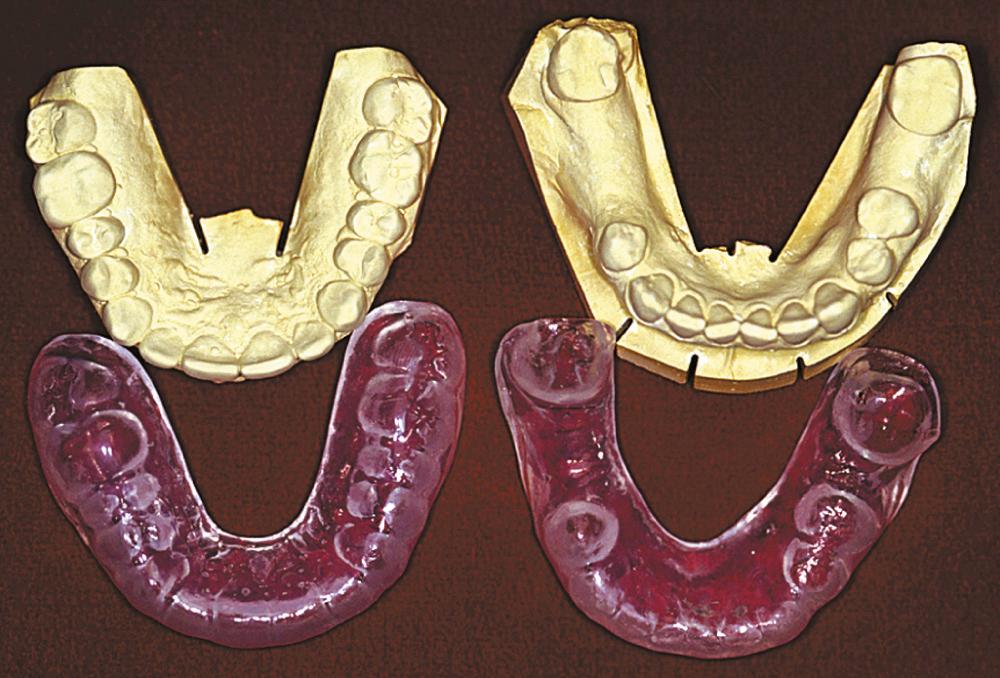
The maxillofacial prosthodontist may be called on to lend support to the radiation oncology team in their efforts to manage dosimetry by way of patient posturing, anatomic displacement or shielding, fabrication of brachytherapy appliances, or construction of devices capable of mimicking normal tissues. Although the devices should be constructed following any oral surgical procedures done in preparation for RT, they must be manufactured before RT simulation appointments in that they must be positioned at the time of simulation.
The undulating topography of head and neck cutaneous structures makes the uniform delivery of radiation difficult at best without the use of boluses constructed of materials considered more or less to be tissue equivalent in terms of their relative resistance to photon or electron penetrance. Consequently, the radiation oncologist may call on the maxillofacial prosthodontic team to assist with facial moulage recording and bolus fabrication when evaluating the physics associated with treating malignant head and neck skin lesions. A facial moulage cast with a gypseous dental stone can aid the radiation oncology team's delineation of a proposed treatment field and prescription of an appropriate bolus thickness before a bolus is constructed of dental baseplate wax or polymethylmethacrylate (PMMA). Boluses can be particularly useful for providing more even dose distributions for nasal ( Fig. 93.2A to G ) or orbital malignancies.
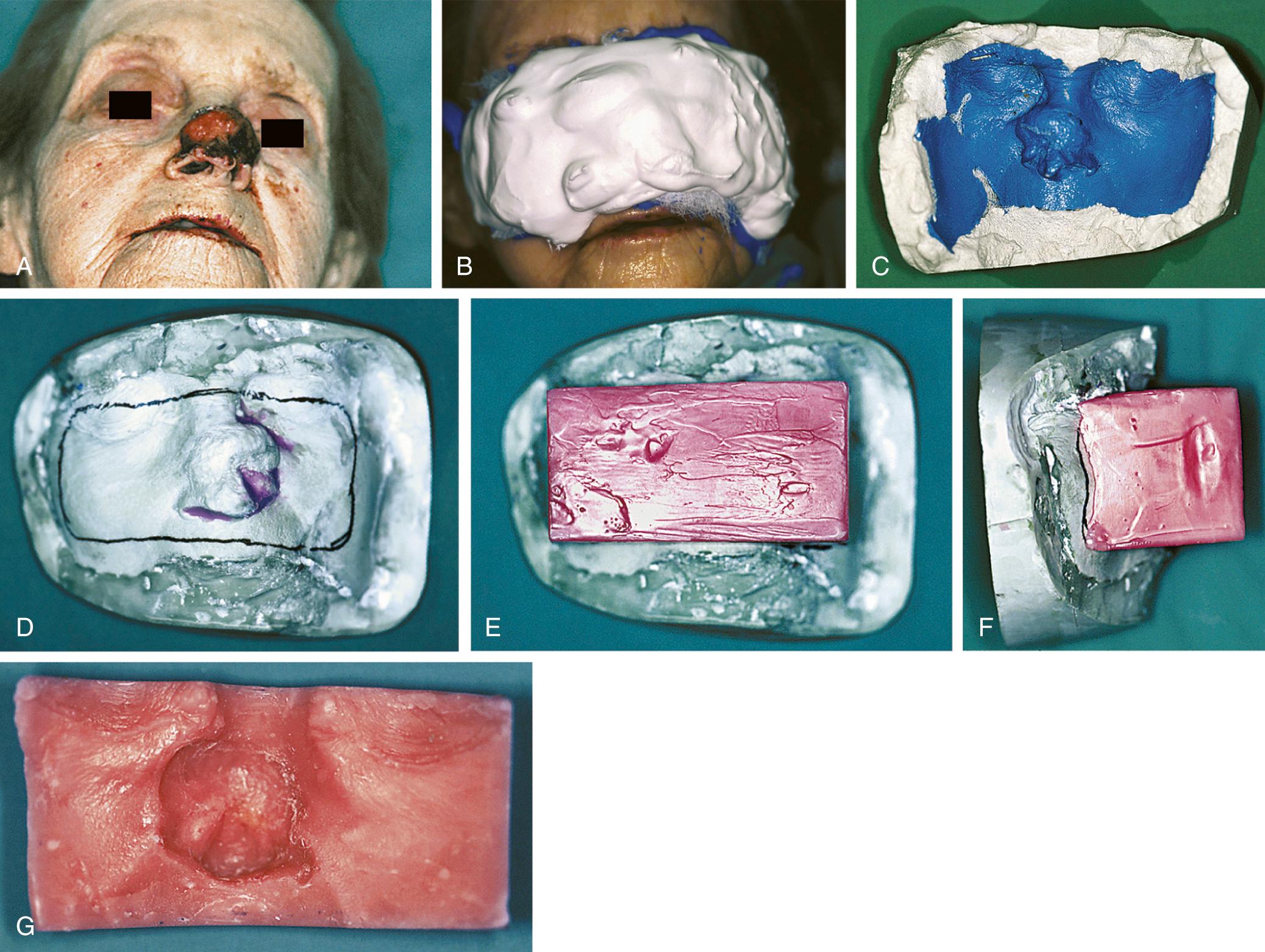
Although Aquaplast masks (Patterson Medical, Bolingbrook, IL) are routinely used to immobilize patients throughout the course of head and neck RT, customized intraoral devices can be used to provide a stable maxillomandibular relationship when attempts are made to precisely localize an external photon or electron beam relative to oral cavity anatomy. Intraoral positioning devices are particularly useful when there is a desire to shield all or part of the maxilla or the mandible from radiation when the opposing jaw is to be included in an external beam field. By positioning the mandible in a prescribed open position with the use of a PMMA appliance that prevents deviation from an arranged spatial relationship to the maxilla, the radiation oncology team can make shielding possible by way of replicable daily positioning of patients from the time of simulation to the completion of RT. This strategy is helpful when mandibular structures are to be spared from sinonasal or maxillary radiation, or when maxillary structures are to be excluded from fields that involve the floor of the mouth, oral tongue, or other sites that encompass the mandible. In addition to stabilizing the maxillomandibular relationship, the incorporation of radiopaque materials such as orthodontic wire, ball bearings, or gutta percha into such devices can lend support to the radiation oncology team's efforts to identify structures for inclusion in proposed radiation fields at the time of simulation ( Fig. 93.3A to E ).
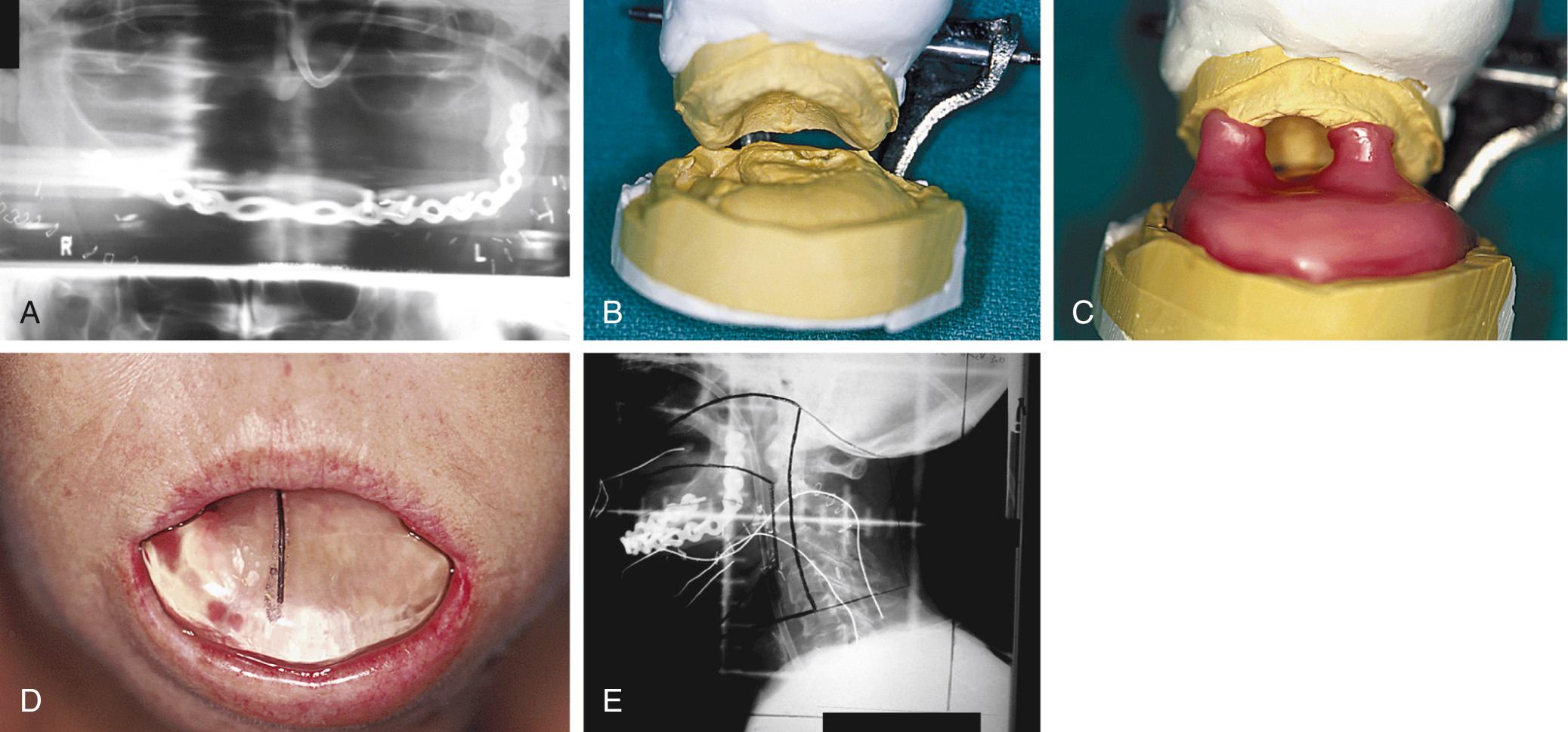
Furthermore, intraoral PMMA appliances can be constructed that harbor Lipowitz alloy. Being the same metal used by radiation oncology teams to create the portals and shields suspended from frames situated between patients and linear accelerator collimators that fashion conventional three-dimensional (3D) conformal RT fields, Lipowitz alloy—a low-fusing combination of lead, bismuth, tin, and cadmium—can suitably shield intraoral anatomy when electron beam therapy is indicated. These devices typically serve the dual purposes of shielding and maxillomandibular positioning, because their interocclusal construction also stabilizes the maxillomandibular relationship. These alloy-containing intraoral appliances are often fabricated for lip ( Fig. 93.4A to C ) and ipsilateral parotid gland ( Fig. 93.5A to C ) fields. The protective intent of these appliances is supplemented when they are constructed in such a fashion as to physically displace soft tissues away from the source of the electron beam. When parotid gland–shielding devices are used, patients are instructed to position the tongue anteriorly during treatment. Doing this while occluding on the interocclusal appliance forces the bulk of the tongue into a contralateral position, where less radiation is encountered. When parotid gland malignancies are treated with a combination of photons and electrons, radiation oncologists sometimes find it helpful to use two appliances, one with Lipowitz alloy and one that lacks metal. The use of the appliance devoid of alloy during the delivery of photons offers the advantages of consistent day-to-day maxillomandibular positioning and soft tissue displacement without the electron backscatter potentially associated with an appliance that harbors a large volume of metal.
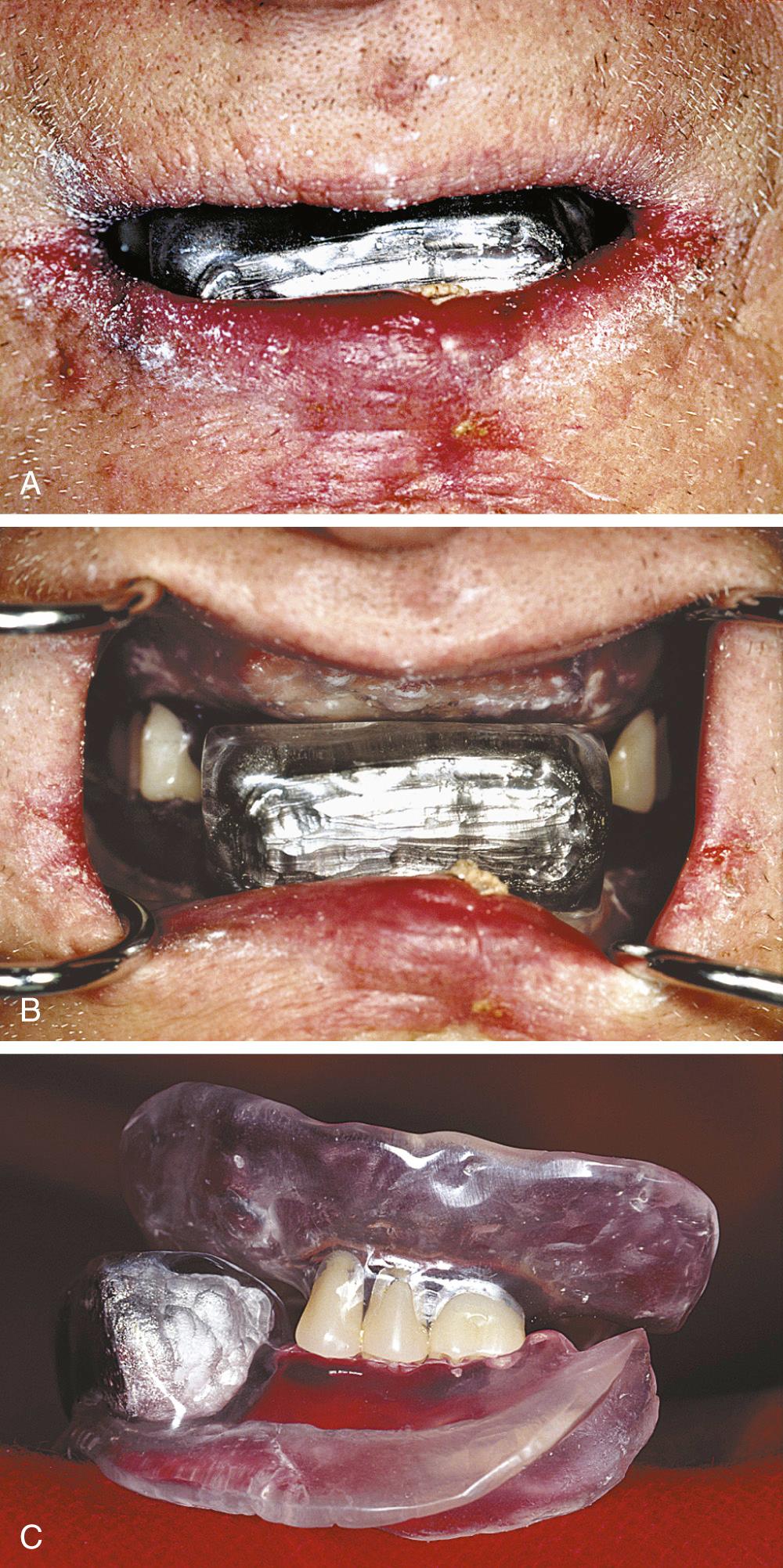
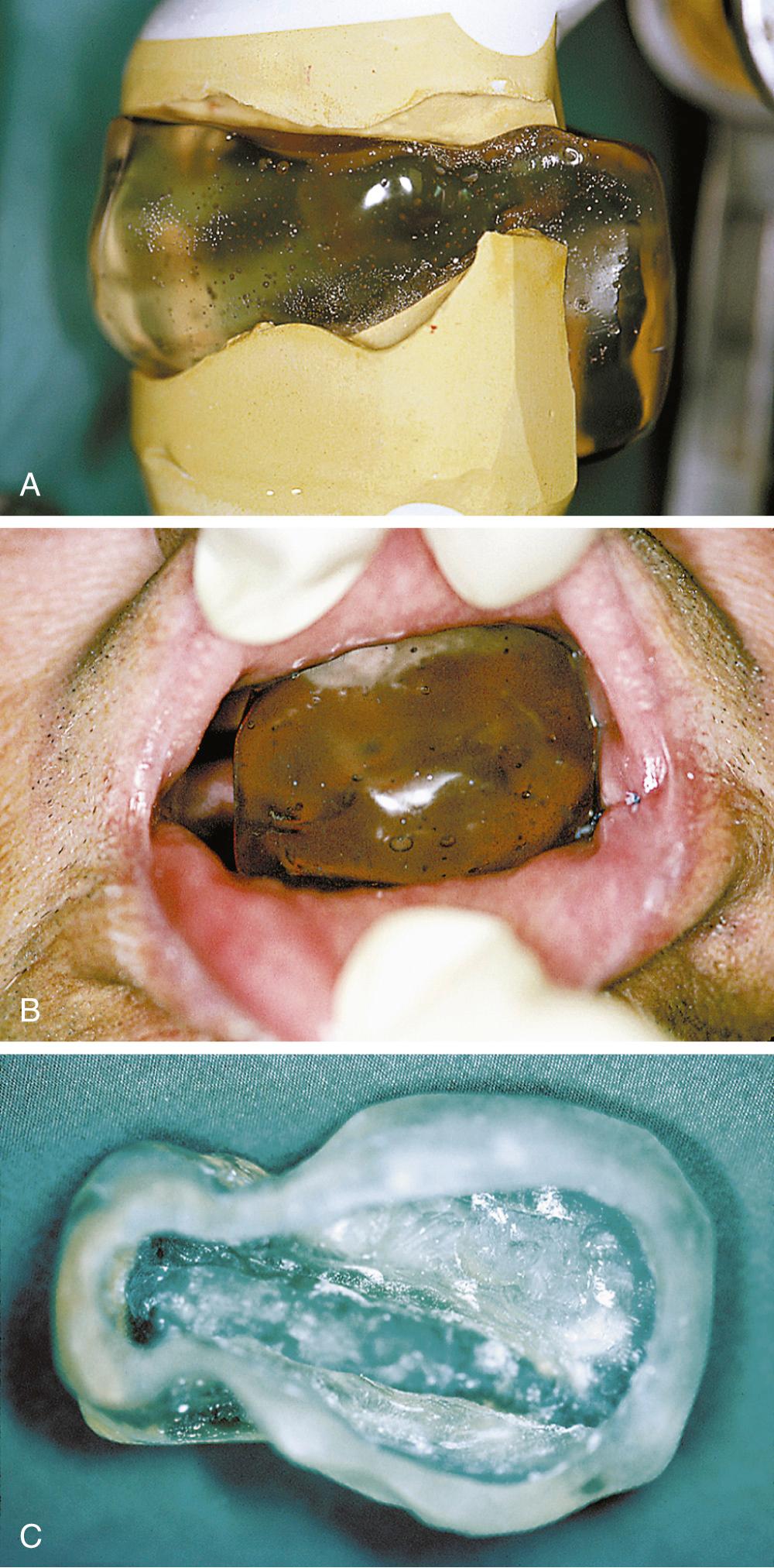
The radiation oncologist's desire for tissue equivalence is not limited to the application of surface boluses, because postoperative tissue voids can give rise to an uneven distribution of radiation that results in suboptimal dosing or overdosing of tissue peripheral to cavernous surgical defects, such as those that result from a maxillectomy. Unfortunately, however, the rigidity of wax and PMMA does not solely allow the dependable use of these materials as intracavitary tissue-mimicking materials by virtue of soft tissue and bony undercuts usually associated with these defects. Consequently, filling an intracavitary void with tissue-equivalent material in the interest of improving RT dose distribution often requires the use of pliable materials that assist daily insertion and removal without unduly traumatizing surrounding tissue. The combination of an inflexible customized intraoral device that stabilizes the maxillomandibular relationship with a pliable material that fills an intracavitary void can, however, overcome the limitations posed by the complex nature of a maxillectomy defect. This combination can be achieved by constructing an intraoral positioning device that incorporates a shelf of PMMA immediately inferior to the maxillectomy defect. The device is capable of supporting a balloon that can be inflated with a tissue-equivalent mixture of radiopaque liquid and water before RT simulation and before each fraction ( Fig. 93.6A to D ).
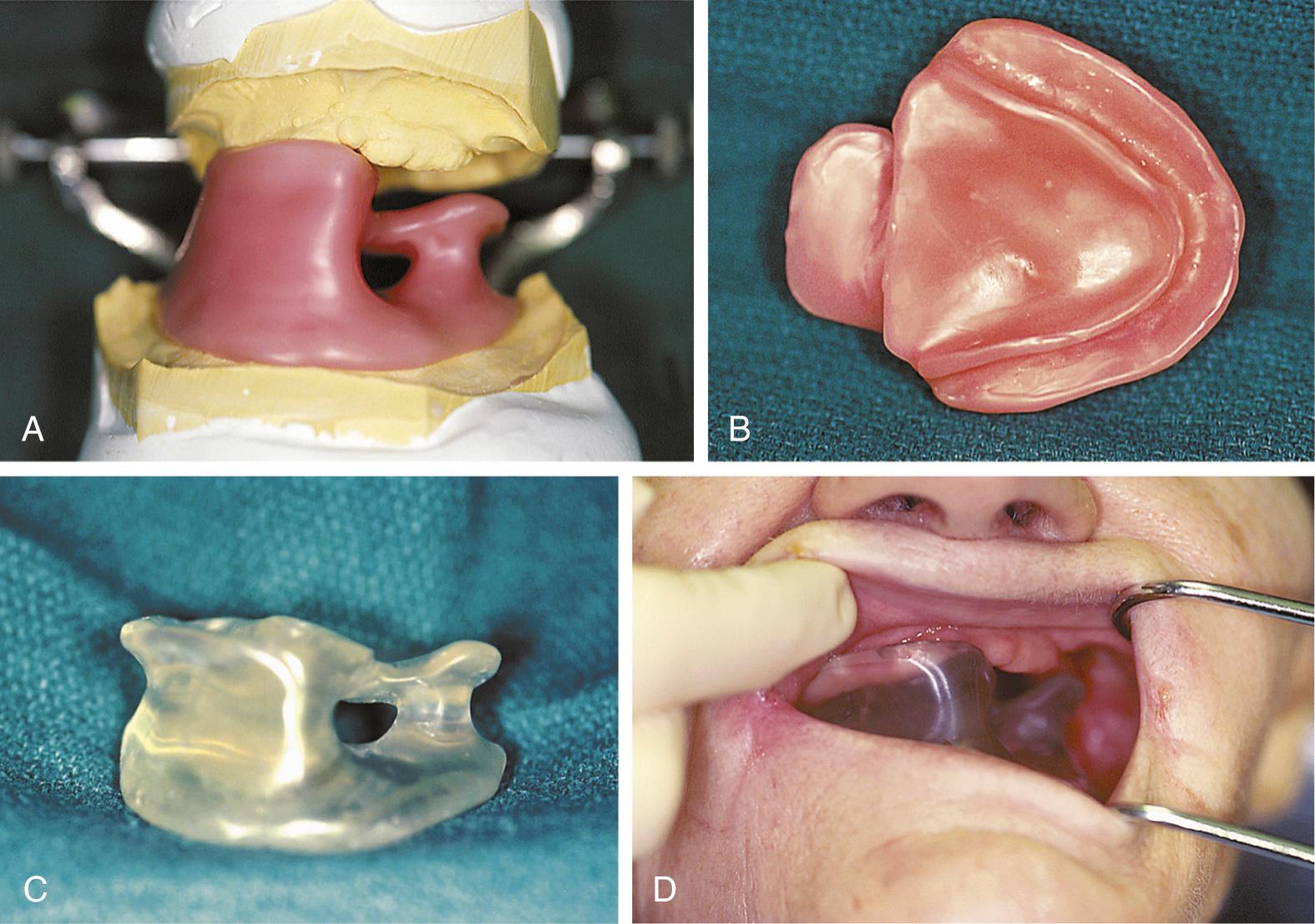
Although the maxillofacial prosthodontist is not likely to lend assistance in the clinical application of interstitial brachytherapy, the management of intracavitary brachytherapy often requires the combined efforts of the radiation oncology and maxillofacial prosthetic teams. The orbit and nasopharynx comprise the most common intracavitary head and neck brachytherapy sites, and the stents used for these sites are typically constructed of PMMA that surrounds catheters into which radioisotopic seeds are inserted. In accord with an intended dose distribution specific for the radioisotope proposed for use, the radiation oncologist or physicist prescribes the catheter positions in consultation with the maxillofacial prosthodontic team after the generation of a master cast from an impression of the site to be treated. When the stents are positioned, they are retained for the duration of treatment by anatomic soft tissue undercuts ( Fig. 93.7A to B ) or dentoalveolar structures.

Recalling patients every 2 to 3 weeks during RT is beneficial from the standpoint of identifying dental, periodontal, and mucosal pathoses that may coincidentally appear or arise secondary to RT. Such a follow-up interval is also meritorious for reinforcing the import of increased hygiene vigilance and the use of topical fluoride gel. It is not uncommon for patients with newly diagnosed life-threatening neoplasms to forget virtually everything that was discussed during an initial maxillofacial prosthodontic evaluation that may have coincided with appointments in otolaryngology, radiation oncology, diagnostic radiology, nuclear medicine, medical oncology, anesthesia, internal medicine, speech pathology, and oral surgery. The overwhelming nature of patients’ initial oncologic experience lends itself to a necessary redundancy with respect to patient communication and education.
Although restorative dental care can be accomplished during RT, procedures that potentially exacerbate mucositis should be avoided. However, particularly in cases that involve oral cavity radiation, patients may reach a point—usually after 2 to 3 weeks of fractionation—at which mucositis is severe enough that they do not want to be subject to dental restorative procedures. Regardless of the need for restorative dental care, a readily concocted mouth rinse to obtund mucositis consists of mixing 1 teaspoon of baking soda and 1 teaspoon of salt in a quart of water that is warmed before use. Alternatively, a compounded solution of tetracycline, diphenhydramine, nystatin, and hydrocortisone—termed “magic mouthwash”—can be obtained from a pharmacy. Two teaspoons of magic mouthwash swished and gargled thrice daily before swallowing serves to mollify radiation-induced stomatitis and pharyngitis.
Follow-up examinations should be arranged every 4 to 8 weeks after the completion of RT, and patients should return to a standard interval thereafter, as long as they comply with hygiene and daily topical fluoride gel regimens. Patients can be considered routine patients in terms of their candidacy for restorative dental care after head and neck RT; however, they must understand that they should not undertake bone-exposing oral surgery within anatomic areas that received more than 5000 cGy of radiation. Such exposures could prompt the development of ORN that could precipitate a pathologic fracture or necessitate a bony resection. Therefore, when patients complete their RT, they should be asked to inform the maxillofacial prosthodontist of any future oral treatment proposal to include tooth extraction, surgical placement of an endosseous titanium implant, or periodontal or endodontic flap surgery in advance so that an estimation of dosimetry can be provided to the surgeon. When these estimates indicate that a bone-exposing violation of mucosa could occur in an area that received more than 5000 cGy of radiation, the Marx hyperbaric oxygen protocol should be considered as an adjunct to the surgical procedure. Marx's hyperbaric oxygen regimen involves 90-minute dives at a barometric pressure of 2.4 atmospheres while breathing 100% oxygen. Twenty dives are undertaken preoperatively, and 10 dives are completed postoperatively in the interest of stimulating an angioneogenesis that partially and irreversibly counteracts the hypovascularity caused by the RT responsible for the increased risk of ORN.
Because dosimetry is highly variable and depends on primary tumor sites, regional metastases, radiation oncology philosophy, and available technology, patients and their dental caregivers cannot be expected to routinely know whether it is safe to go forward with bone-exposing oral surgical interventions after RT. Consequently, it is incumbent on the maxillofacial prosthodontist to assist this determination, whether the prosthodontist personally accepts this responsibility or shares it with radiation oncology personnel. When patients have been treated with conventional 3-D conformal RT, possession of simulation and portal radiographs and radiation oncology records sometimes allows the prosthodontist to establish a relative risk for surgically precipitated ORN without the assistance of a physician or a physicist. On the other hand, when intensity-modulated radiation therapy (IMRT)—the latest 3-D conformal radiation modality—is used, a greater reliance on the radiation oncologist and/or radiation physicist may be necessary.
Oral surgical planning after conventional 3-D conformal RT first involves the acquisition of simulation and portal radiographs as well as a complete description of the radiation oncologist's dosimetric and clinical assessments. Although the possession of simulation and portal radiographs provides the dental team a mere two-dimensional perception of the fields prescribed by the radiation oncologist, their value in determining whether dentoalveolar structures of interest lie within or without treatment fields allows for surgical treatment planning, often without the need for further conference with radiation oncology personnel . When parallel opposed-field simulation and portal radiographs are shown to encompass dentoalveolar structures, the dental team must take for granted the fact that an invasive procedure within that field will place the patient at risk for ORN if the prescribed dose to that field surpassed 5000 cGy . However, as is frequently the case in head and neck radiation oncology, the exclusion of dentoalveolar structures anterior, superior, or inferior to a field boundary allows surgical intervention in the excluded area without risking ORN ( Fig. 93.8A and B ), because ORN by definition comprises a volume of necrotic bone within an RT field. Uncertainty can arise, however, when treatment field borders bisect or tangentially appose dentoalveolar structures to be included in a proposed surgical intervention. Although dosages at the borders of conventional 3-D conformal RT fields approximate only 50% of the prescribed dose, patient positioning can vary by as much as 5 mm in any given dimension despite exceptional efforts on the part of radiation oncology teams to reproducibly orient their patients on a daily basis. Considering the possibility of positioning errors during the course of daily RT sessions, such scenarios warrant erring on the side of caution with the assumption that affected field border areas could become osteoradionecrotic after a surgical insult.
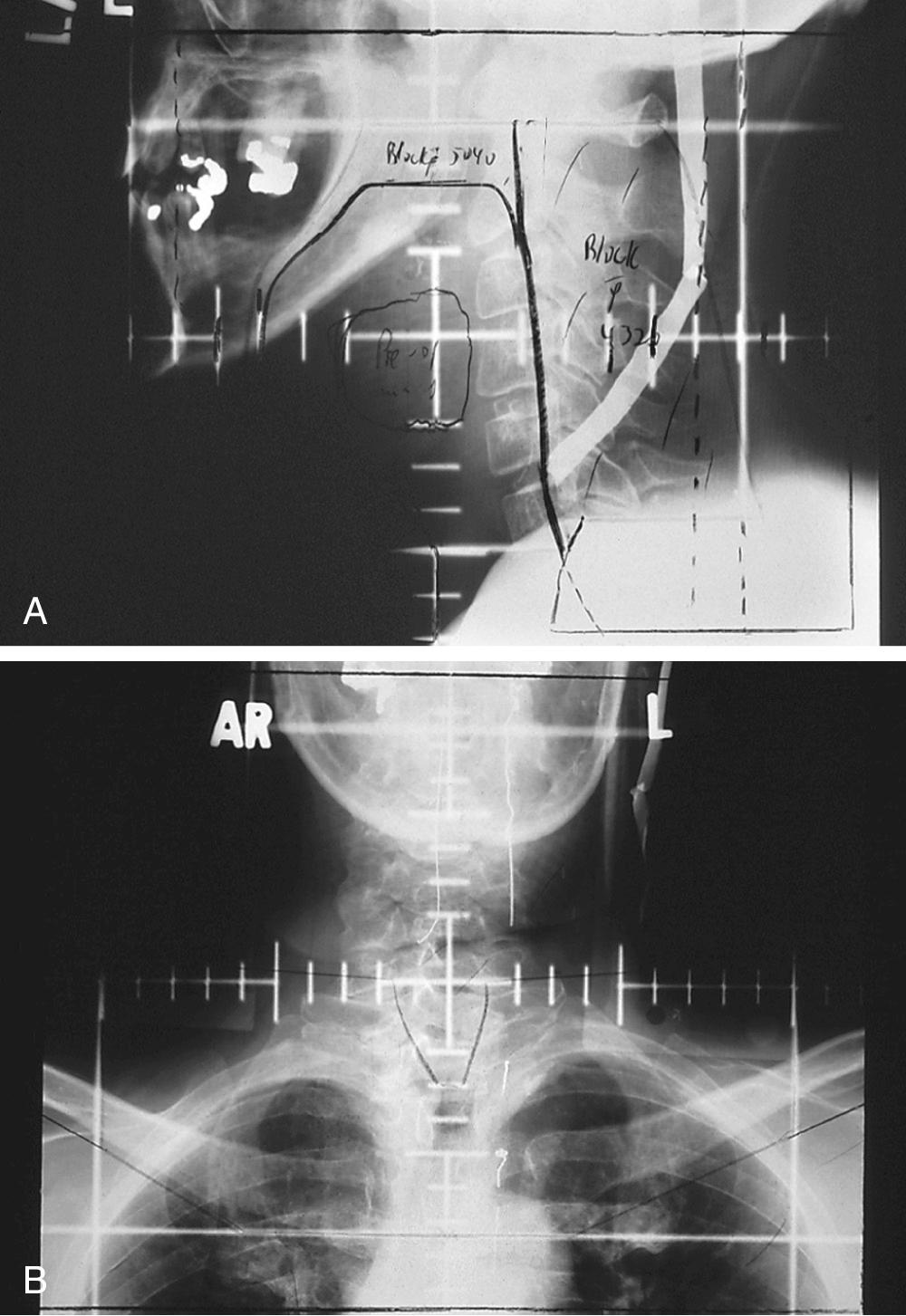
Likewise, when ipsilateral dentoalveolar structures are found within unilateral treatment fields where photon doses exceed 5000 cGy, it can be assumed that ipsilateral oral surgical procedures within that field would place a patient at great risk for ORN. Conversely, the risk for contralateral, oral surgery–induced ORN can be relatively low for such a patient, considering the fact that only about one third of a conventionally prescribed photon dose would reach contralateral dentoalveolar structures. However, because the use of electron beams; uniform, oblique, or wedged-pair multiple fields; or appositional fields can complicate dosimetric deductions made with the use of simulation and portal radiographs and a medical record narrative, it is always reasonable to confer with the radiation oncologist or physicist when questions arise before invasive oral surgical procedures. The potential debility associated with the precipitation of ORN merits such caution.
In contrast to conventional 3-D conformal RT, in which gantry positions are limited and static, IMRT can be delivered by way of a mobile collimator. The collimator arcs across several swaths of parallel appositional fields, while two rows of tungsten leaves within the collimator ( Fig. 93.9A and B ) concentrically open and close to strategically deliver radiation to targeted tissues while sparing normal structures of the highest radiation burdens. In another technique that has come to be known as step-and-shoot intensity-modulated radiation therapy, radiation is directed from multiple stationary gantry positions that are each uniquely and statically collimated through the use of multiple layers of tungsten leaves capable of converging from the periphery of the linear accelerator's nonadjustable port to fashion customized portal shapes in accord with the radiation oncologist's or physicist's treatment prescription ( Fig. 93.10 ). In either scenario, IMRT simulation is based on an interface between computed tomography (CT) imaging and dosimetric treatment planning software such as the Corvus system. As such, IMRT simulation and portal radiographs offer limited or no value for establishing surgically induced ORN risks after RT, and IMRT dosimetry must be evaluated using software that is at this time almost universally unavailable to any dental team. This software, however, offers an evaluation of each computer-generated tomographic slice that is so detailed in its resolution that anatomic structures as small as individual tooth roots can be identified, and dosages can be estimated at the pinpoint level of a computer mouse cursor superimposed over the area of dosimetric interest. Because Corvus and other IMRT software firms offer axial, sagittal, and coronal tomography sections, a comprehensive 3-D depiction of dosimetry can be achieved by means of a review of computer records. This can be done without the need for assessing multiple simulation and portal radiographs that may be geometrically confusing, tattered from age, untidily drawn, of poor radiographic quality, or entirely lost or discarded.
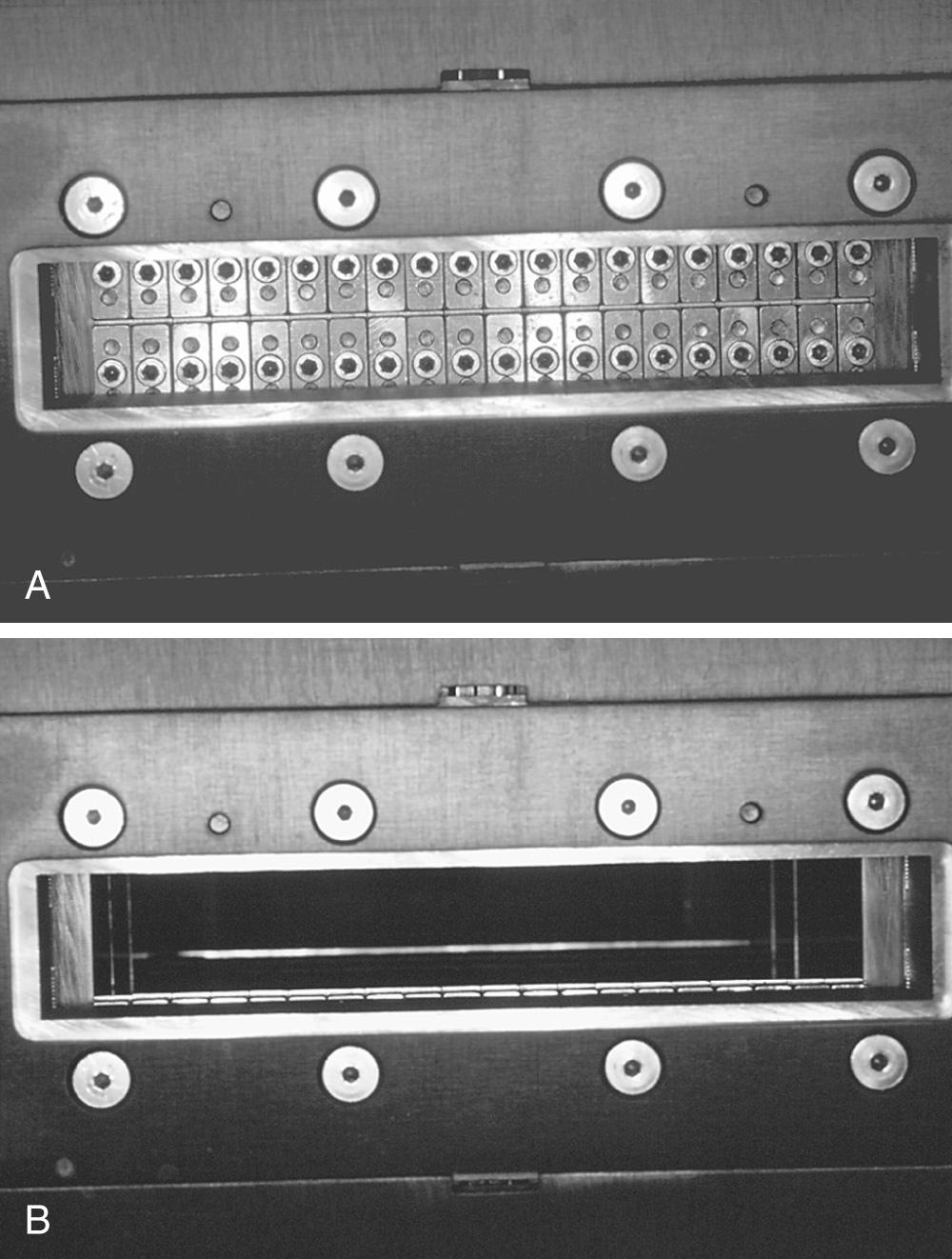
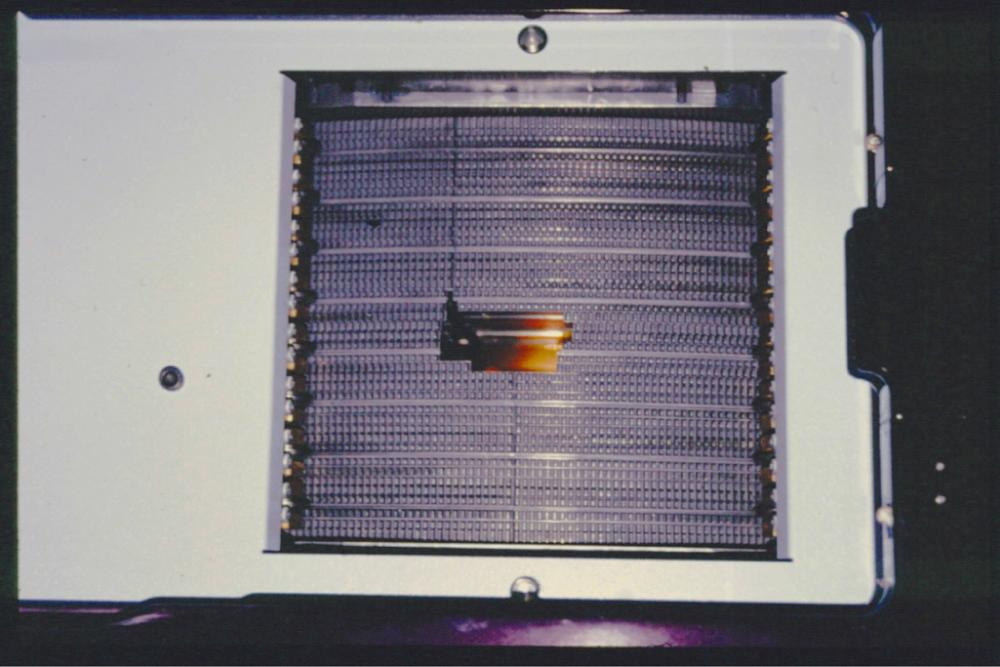
Although IMRT dosimetric evaluations performed in the interest of establishing the relative safety of proposed dental interventions are readily achieved by way of the dental team's access to computer records, when maxillofacial prosthodontic support is found in the facility in which a patient's therapy was delivered, communicative problems can arise between dental and radiation oncology personnel when they are separated geographically. Radiation oncology personnel are not always familiar with dental anatomy and terminology or oral surgical procedures, and dental personnel are not generally knowledgeable about IMRT computer simulation packages or the general delivery of IMRT. It can thus benefit dental practitioners routinely involved in invasive oral procedures to personally meet a radiation oncology team involved in the delivery of IMRT before encountering their first head and neck IMRT patient. Conversely, dental personnel can share an oral surgical treatment plan with a patient's radiation oncology team face-to-face when they first encounter a patient treated with IMRT. Either way, an initial interdisciplinary conference at the IMRT facility could lend clarification to each team's needs and concerns when future patients are shared and fiscal, travel, and time constraints make it impractical or impossible to convene personally. Once dental and IMRT providers possess a working knowledge of one another's methodologies and concerns, distant communication can be assisted. The most convenient means by which to request dosimetric data from a remote IMRT center involves obtaining printed, colorized serial CTs that display isodose information superimposed over imaged anatomy ( Fig. 93.11A and B ). These images are generated by all IMRT computer packages and offer a reasonable representation in three dimensions of dosages delivered. A common impediment to dental teams’ treatment planning efforts involves their receipt of black-and-white photocopied CT isodose images that are essentially illegible by virtue of the fact that IMRT computer packages routinely rely on the use of color for the assignment of dosimetric values.
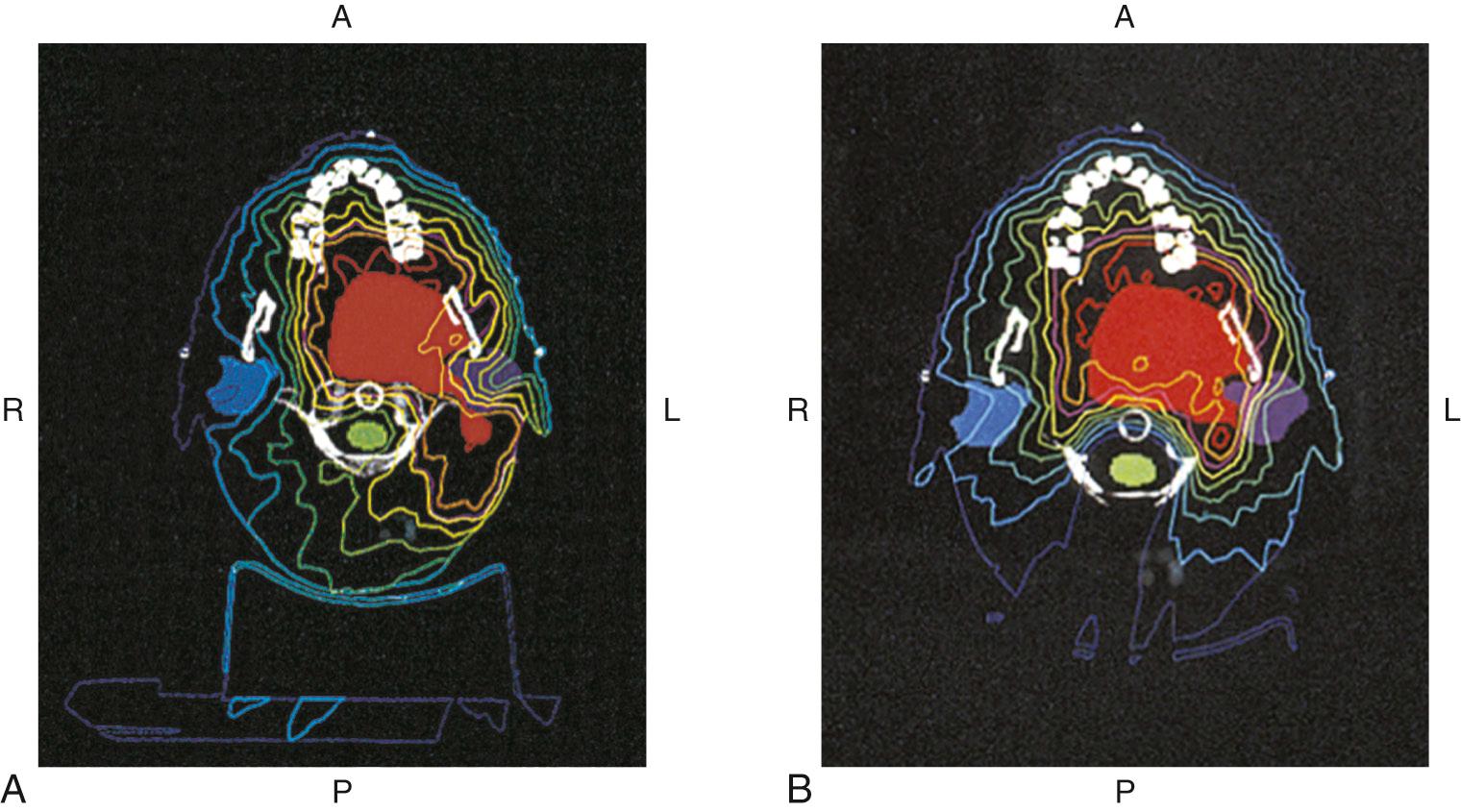
The maxillofacial prosthodontic team's involvement in the care of head and neck cancer patients who will receive RT is initially focused on treatment planning in the interest of preventing ORN and the preparation for any prosthetic rehabilitation necessitated by that treatment planning or a patient's comprehensive oncologic management. The maxillofacial prosthodontist also participates in decision making intended to diminish the risk of ORN for patients obliged to undertake oral or maxillofacial surgical procedures after RT. Because these efforts are usually multidisciplinary to the extent that decisions made by any of those involved in the treatment of an oncology patient could affect the maxillofacial prosthodontic team's treatment options, participation in multidisciplinary head and neck tumor board conferences is constructive. Additionally, with support from the general dental and oral hygiene communities, the maxillofacial prosthodontist contributes to preventive dental health education and care from the outset of the oncologic experience through what should become a lifelong follow-up relationship. Furthermore, maxillofacial prosthodontic personnel can assist the radiation oncology team with intraoral and extraoral devices that repeatedly position and shield anatomy, serve as tissue-equivalent material to allow a more even dose distribution of external radiation beams, or situate radioisotopic sources for intracavitary brachytherapy. Finally, the participation of maxillofacial prosthodontic team members at the commencement of any head and neck oncologic treatment is meritorious in that the often complex intraoral and extraoral rehabilitation of anatomic deficits acquired before, during, or after that treatment is germane to the traditional role of maxillofacial prosthodontists.
Become a Clinical Tree membership for Full access and enjoy Unlimited articles
If you are a member. Log in here